brake JAGUAR S TYPE 2005 1.G Technical Guide Update
[x] Cancel search | Manufacturer: JAGUAR, Model Year: 2005, Model line: S TYPE, Model: JAGUAR S TYPE 2005 1.GPages: 133, PDF Size: 3.48 MB
Page 6 of 133

Contents
1
Subject Page
Glossary
Abbreviations 3
Introduction4
Vehicle Weights 5
Dimensions 5
Vehicle Features 6
Body
Body Structure 10
Engine Compartment 15
Trunk 16
Jacking and Towing 18
Glazing 19
Doors and Door Mirrors 21
Windshield Wipers and Washers 23
Exterior and Interior Trim 24
Seats 26
Interior Features 30
Occupant Protection
Seat Belts 32
Airbags 33
SRS Operation 35
Fuel System
Introduction 38
Evaporative Emissions System 42
Exhaust System
Introduction 44
Transmission
Introduction 45
Chassis
Introduction 46
Front Suspension 47
Rear Suspension 49
Wheels and Tyres 52
Driveline 53
Final Drive (differential) 54
Brakes 55
Power Assisted Steering 58
Steering Column 59
Climate Control
System Overview 63
continued:
JAGUARS-TYPE
Page 9 of 133
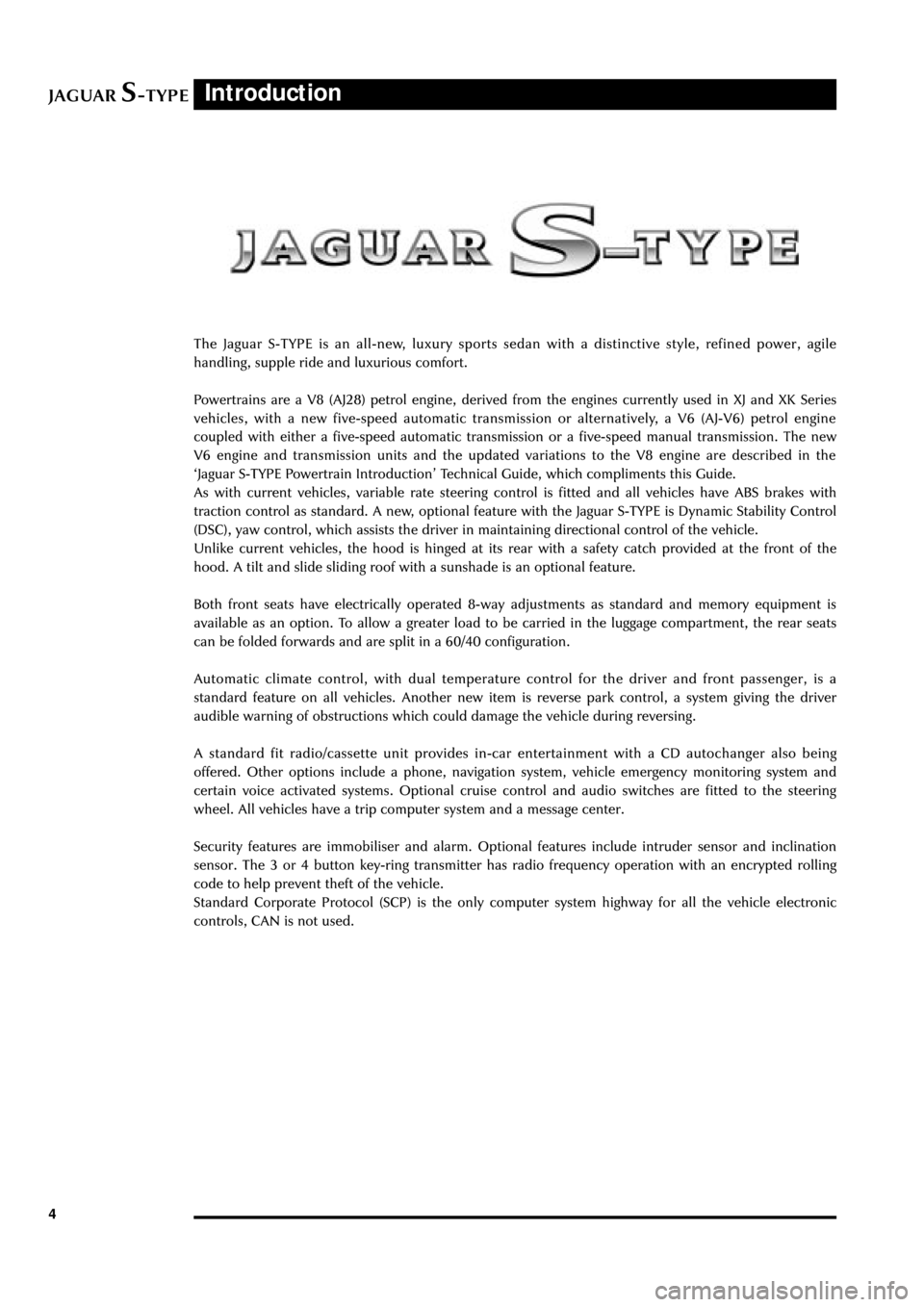
JAGUARS-TYPE
4
Introduction
The Jaguar S-TYPE is an all-new, luxury sports sedan with a distinctive style, refined power, agile
handling, supple ride and luxurious comfort.
Powertrains are a V8 (AJ28) petrol engine, derived from the engines currently used in XJ and XK Series
vehicles, with a new five-speed automatic transmission or alternatively, a V6 (AJ-V6) petrol engine
coupled with either a five-speed automatic transmission or a five-speed manual transmission. The new
V6 engine and transmission units and the updated variations to the V8 engine are described in the
ÔJaguar S-TYPE Powertrain IntroductionÕ Technical Guide, which compliments this Guide.
As with current vehicles, variable rate steering control is fitted and all vehicles have ABS brakes with
traction control as standard. A new, optional feature with the Jaguar S-TYPE is Dynamic Stability Control
(DSC), yaw control, which assists the driver in maintaining directional control of the vehicle.
Unlike current vehicles, the hood is hinged at its rear with a safety catch provided at the front of the
hood. A tilt and slide sliding roof with a sunshade is an optional feature.
Both front seats have electrically operated 8-way adjustments as standard and memory equipment is
available as an option. To allow a greater load to be carried in the luggage compartment, the rear seats
can be folded forwards and are split in a 60/40 configuration.
Automatic climate control, with dual temperature control for the driver and front passenger, is a
standard feature on all vehicles. Another new item is reverse park control, a system giving the driver
audible warning of obstructions which could damage the vehicle during reversing.
A standard fit radio/cassette unit provides in-car entertainment with a CD autochanger also being
offered. Other options include a phone, navigation system, vehicle emergency monitoring system and
certain voice activated systems. Optional cruise control and audio switches are fitted to the steering
wheel. All vehicles have a trip computer system and a message center.
Security features are immobiliser and alarm. Optional features include intruder sensor and inclination
sensor. The 3 or 4 button key-ring transmitter has radio frequency operation with an encrypted rolling
code to help prevent theft of the vehicle.
Standard Corporate Protocol (SCP) is the only computer system highway for all the vehicle electronic
controls, CAN is not used.
Page 18 of 133
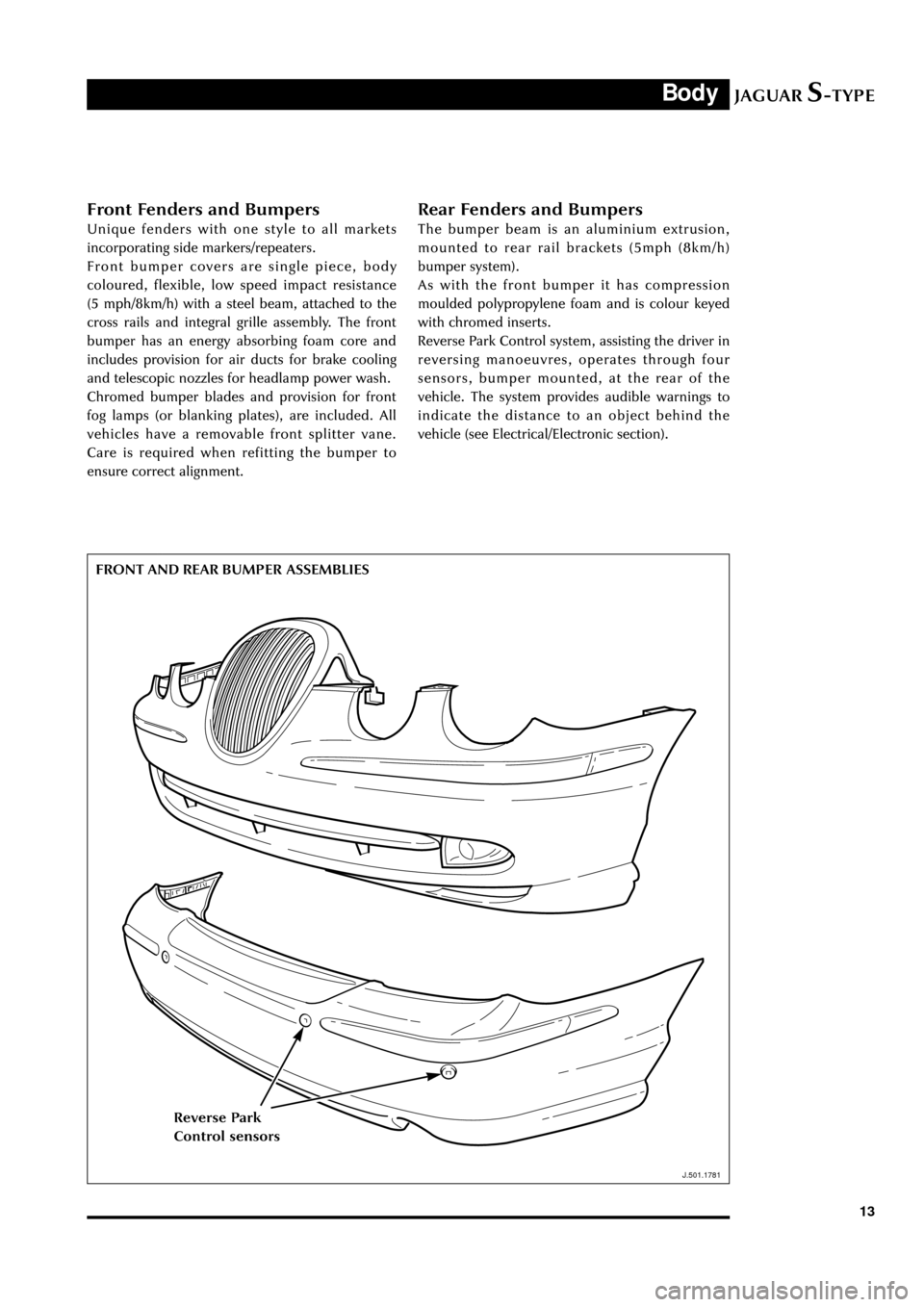
JAGUARS-TYPEBody
13
Front Fenders and Bumpers
Unique fenders with one style to all markets
incorporating side markers/repeaters.
Front bumper covers are single piece, body
coloured, flexible, low speed impact resistance
(5 mph/8km/h) with a steel beam, attached to the
cross rails and integral grille assembly. The front
bumper has an energy absorbing foam core and
includes provision for air ducts for brake cooling
and telescopic nozzles for headlamp power wash.
Chromed bumper blades and provision for front
fog lamps (or blanking plates), are included. All
vehicles have a removable front splitter vane.
Care is required when refitting the bumper to
ensure correct alignment.
Rear Fenders and Bumpers
The bumper beam is an aluminium extrusion,
mounted to rear rail brackets (5mph (8km/h)
bumper system).
As with the front bumper it has compression
moulded polypropylene foam and is colour keyed
with chromed inserts.
Reverse Park Control system, assisting the driver in
reversing manoeuvres, operates through four
sensors, bumper mounted, at the rear of the
vehicle. The system provides audible warnings to
indicate the distance to an object behind the
vehicle (see Electrical/Electronic section).
FRONT AND REAR BUMPER ASSEMBLIES
J.501.1781
Reverse Park
Control sensors
Page 20 of 133
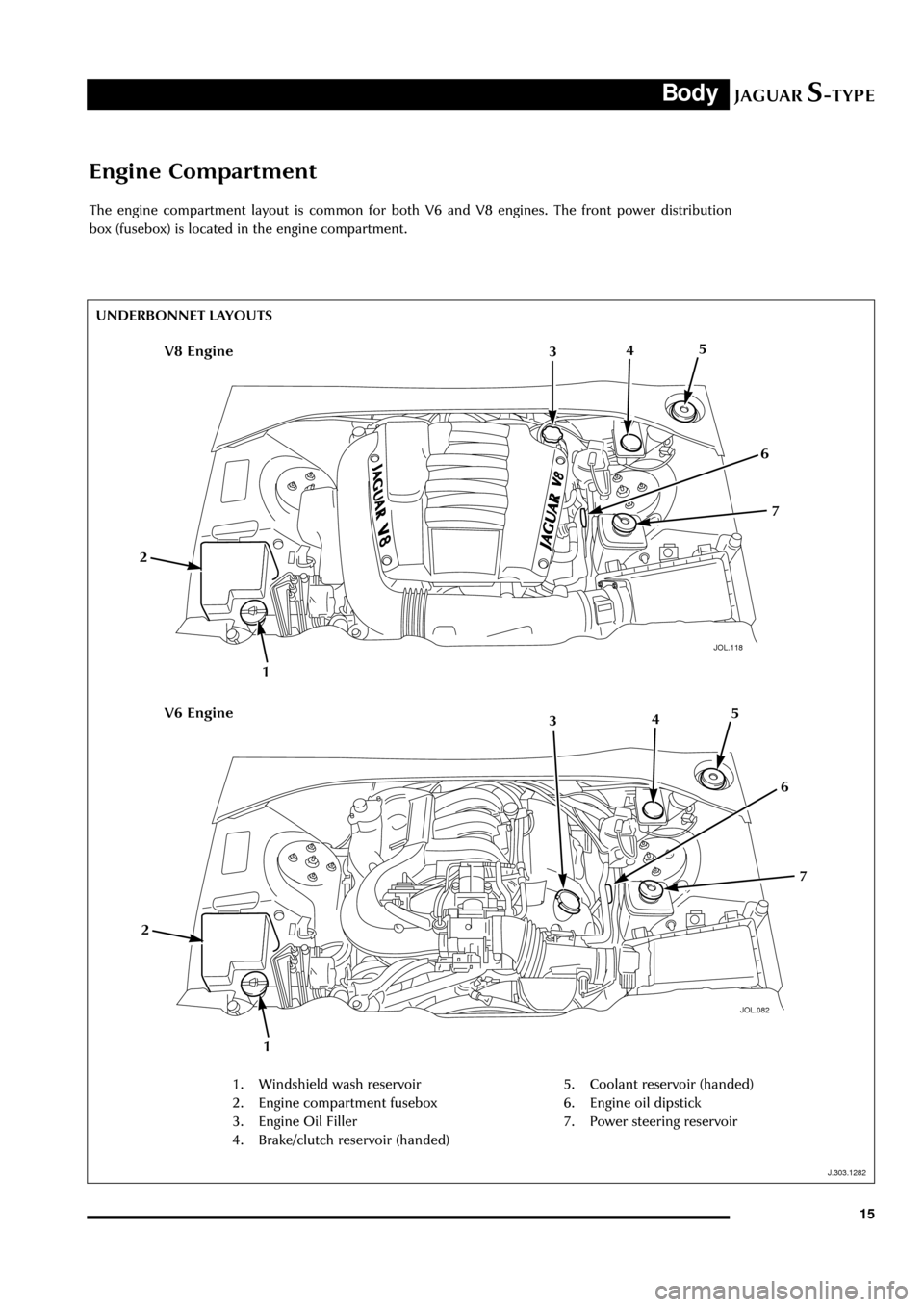
JAGUARS-TYPEBody
15
Engine Compartment
The engine compartment layout is common for both V6 and V8 engines. The front power distribution
box (fusebox) is located in the engine compartment.
JOL.118
UNDERBONNET LAYOUTS
J.303.1282
1
V8 Engine
JOL.082
V6 Engine
1. Windshield wash reservoir
2. Engine compartment fusebox
3. Engine Oil Filler
4. Brake/clutch reservoir (handed)5. Coolant reservoir (handed)
6. Engine oil dipstick
7. Power steering reservoir
543
2
7
6
1
543
2
7
6
Page 50 of 133
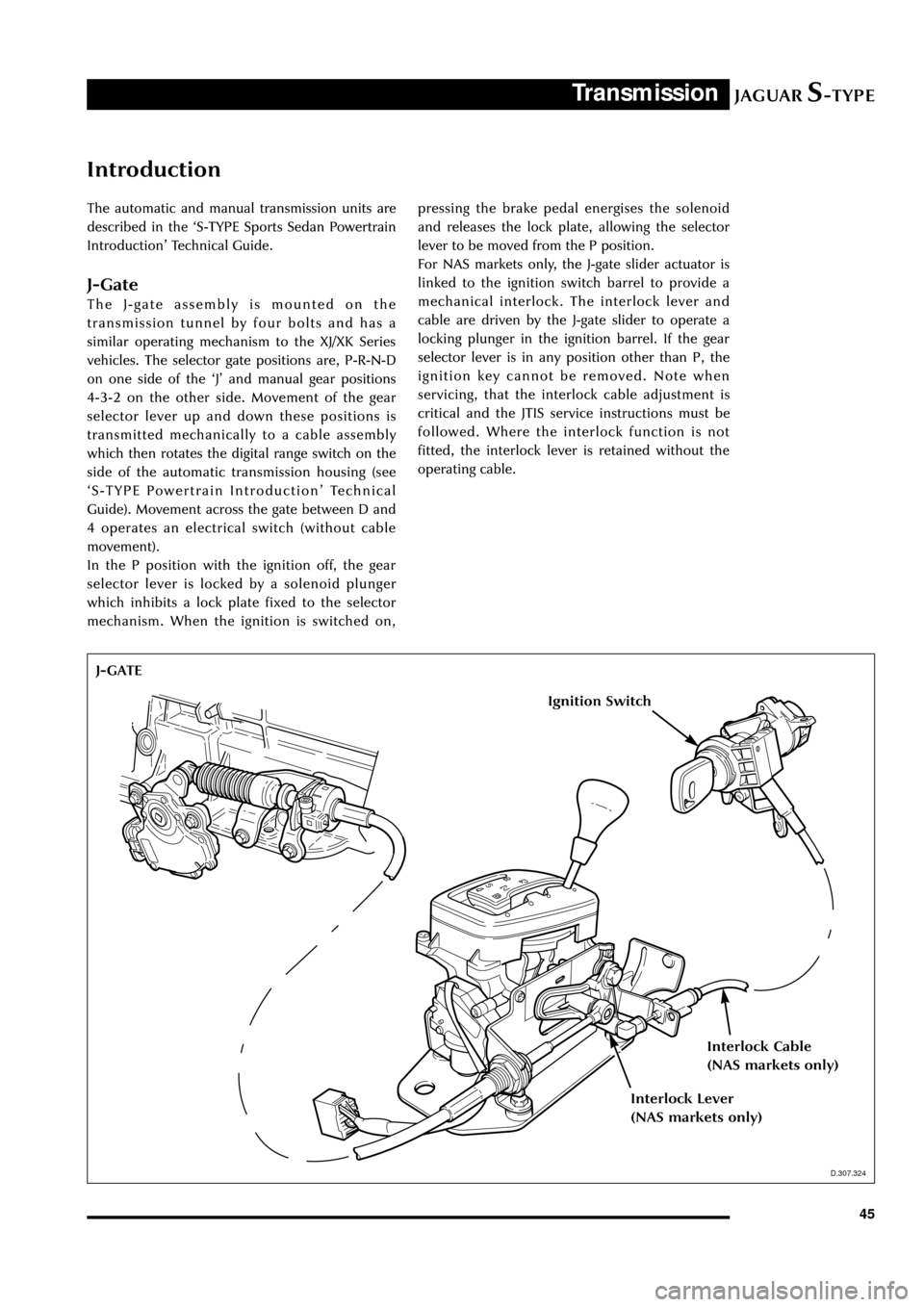
JAGUARS-TYPETransmission
45
Introduction
The automatic and manual transmission units are
described in the ÔS-TYPE Sports Sedan Powertrain
IntroductionÕ Technical Guide.
J-Gate
The J-gate assembly is mounted on the
transmission tunnel by four bolts and has a
similar operating mechanism to the XJ/XK Series
vehicles. The selector gate positions are, P-R-N-D
on one side of the ÔJÕ and manual gear positions
4-3-2 on the other side. Movement of the gear
selector lever up and down these positions is
transmitted mechanically to a cable assembly
which then rotates the digital range switch on the
side of the automatic transmission housing (see
ÔS-TYPE Powertrain IntroductionÕ Technical
Guide). Movement across the gate between D and
4 operates an electrical switch (without cable
movement).
In the P position with the ignition off, the gear
selector lever is locked by a solenoid plunger
which inhibits a lock plate fixed to the selector
mechanism. When the ignition is switched on,pressing the brake pedal energises the solenoid
and releases the lock plate, allowing the selector
lever to be moved from the P position.
For NAS markets only, the J-gate slider actuator is
linked to the ignition switch barrel to provide a
mechanical interlock. The interlock lever and
cable are driven by the J-gate slider to operate a
locking plunger in the ignition barrel. If the gear
selector lever is in any position other than P, the
ignition key cannot be removed. Note when
servicing, that the interlock cable adjustment is
critical and the JTIS service instructions must be
followed. Where the interlock function is not
fitted, the interlock lever is retained without the
operating cable.
D.307.324
J-GATE
Ignition Switch
Interlock Cable
(NAS markets only)
Interlock Lever
(NAS markets only)
D.307.324
Page 52 of 133
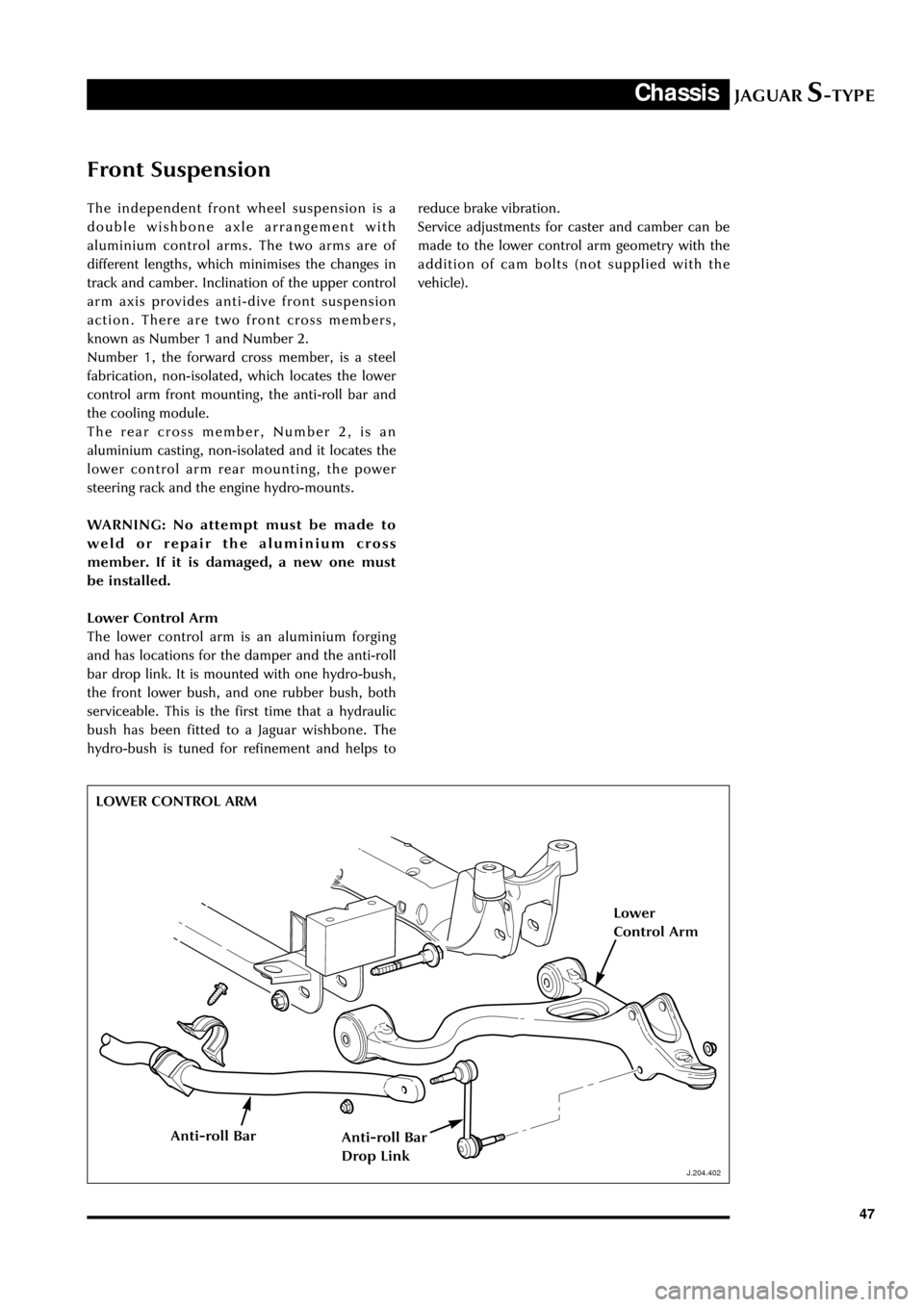
JAGUARS-TYPEChassis
47
Front Suspension
The independent front wheel suspension is a
double wishbone axle arrangement with
aluminium control arms. The two arms are of
different lengths, which minimises the changes in
track and camber. Inclination of the upper control
arm axis provides anti-dive front suspension
action. There are two front cross members,
known as Number 1 and Number 2.
Number 1, the forward cross member, is a steel
fabrication, non-isolated, which locates the lower
control arm front mounting, the anti-roll bar and
the cooling module.
The rear cross member, Number 2, is an
aluminium casting, non-isolated and it locates the
lower control arm rear mounting, the power
steering rack and the engine hydro-mounts.
WARNING: No attempt must be made to
weld or repair the aluminium cross
member. If it is damaged, a new one must
be installed.
Lower Control Arm
The lower control arm is an aluminium forging
and has locations for the damper and the anti-roll
bar drop link. It is mounted with one hydro-bush,
the front lower bush, and one rubber bush, both
serviceable. This is the first time that a hydraulic
bush has been fitted to a Jaguar wishbone. The
hydro-bush is tuned for refinement and helps to
J.204.402
reduce brake vibration.
Service adjustments for caster and camber can be
made to the lower control arm geometry with the
addition of cam bolts (not supplied with the
vehicle).
LOWER CONTROL ARM
J.204.402
Lower
Control Arm
Anti-roll BarAnti-roll Bar
Drop Link
Page 53 of 133
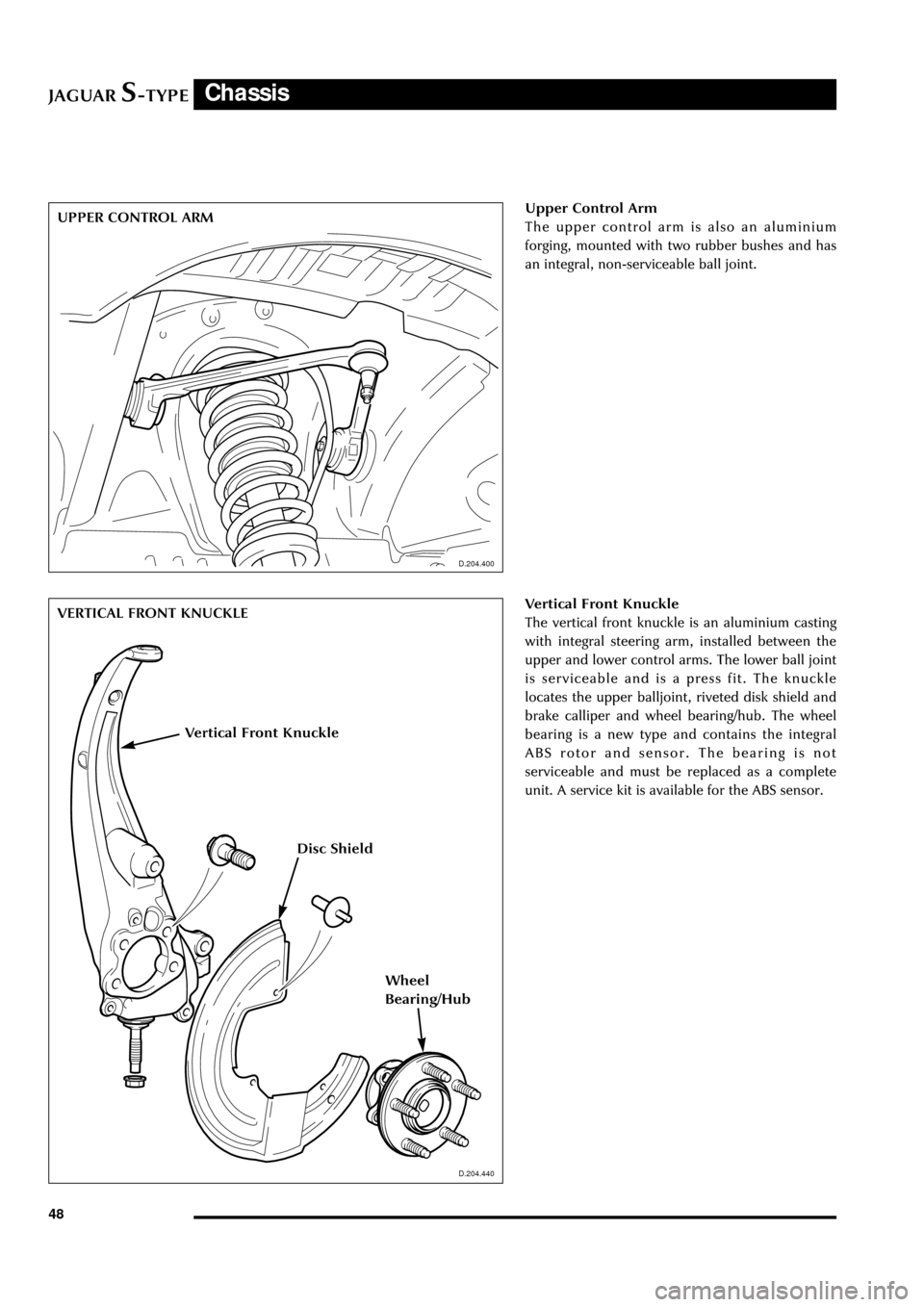
JAGUARS-TYPE
D.204.400
Chassis
48
D.204.440
VERTICAL FRONT KNUCKLE UPPER CONTROL ARM
D.204.440
D.204.400
Upper Control Arm
The upper control arm is also an aluminium
forging, mounted with two rubber bushes and has
an integral, non-serviceable ball joint.
Vertical Front Knuckle
The vertical front knuckle is an aluminium casting
with integral steering arm, installed between the
upper and lower control arms. The lower ball joint
is serviceable and is a press fit. The knuckle
locates the upper balljoint, riveted disk shield and
brake calliper and wheel bearing/hub. The wheel
bearing is a new type and contains the integral
ABS rotor and sensor. The bearing is not
serviceable and must be replaced as a complete
unit. A service kit is available for the ABS sensor.
Vertical Front Knuckle
Disc Shield
Wheel
Bearing/Hub
Page 60 of 133

JAGUARS-TYPEChassis
55
Brakes
Brake Control Module
Brakes are controlled with a Teeves Mk 20E brake
modulator.
The anti-lock brake/traction control, control
module (ABS/TCCM) contains the integral software
for ABS and traction control, similar to current XJ
and XK Series vehicles. It is supplied as a 10 valve,
4-channel module and calibration is the same to
all powertrains. It is connected to the SCP bus for
traction control, warnings and vehicle speed.
Dynamic Stability Control
Dynamic stability control (DSC) is a new Jaguar
safety feature, which uses ABS and traction
control to control yaw movements of the vehicle.
Yaw is the rotary motion of the vehicle on its
vertical axis, a force that would cause oversteer or
oversteer or sideslip. The dynamic stability
control module (DSCM) contains the same
software as described but with the addition of IVD
software. The modulator is supplied as a 12 valve,
4-channel module calibrated for base suspension
only. The connectors differ between the two; the
10 valve unit has a 25-way with sliding cam, as
D.206.254
D.206.175
BRAKE CONTROL MODULE
BRAKE SYSTEM LAYOUT
Page 61 of 133

JAGUARS-TYPEChassis
56
D.206.177
current vehicles and the 12 valve unit has a 47-
way connector with lever cam. DSC calculates the
real vehicle motion (forward and gearing) and
compares it to the direction initially chosen by the
driver. A steering rate sensor is located on the
steering column and is used to calculate steering
angle. A yaw rate sensor and lateral accelerometer
are located on a bracket behind the hand brake
lever and are used to calculate the vehicle under
or over steer and any side slip.
As soon as DSC recognises that the driver is not
reacting sufficiently to compensate a deviation,
DSC intervenes by applying brake force to each of
the four wheels individually to control yaw
Front Wheel Sensor
The front wheel active ABS speed sensors are
incorporated into the wheel bearings, connected
via a flying lead routed along the brake hose.
Rear Wheel Sensor
The rear sensors are mounted on the hub carrier
and connected by a flying lead routed along the
control arm. None of the sensors are adjustable.
Wheel speed sensors are new active sensors,
which are more sensitive at lower speeds that the
current saloon and sports wheel speed sensors.
Front and Rear Callipers
Front callipers are twin piston aluminium
construction. The ventilated disc sizes are 300 mm
x 32 mm. The rear brakes have cast iron callipers.
This is because of the hand brake operation using
the rear callipers. The ventilated disc sizes are 288
mm x 20 mm. Each rear calliper has a ball and
ramp park brake mechanism, operating on the
main calliper pads.
D.206.178
D.206.177
FRONT WHEEL SENSOR
REAR WHEEL SENSOR
D.206.178
Page 62 of 133

JAGUARS-TYPEChassis
57
D.206.176
BRAKE BOOSTER Brake Booster
The brake booster is a Lucas unit mounted on the
engine bay bulkhead with a 25.4mm diameter
master cylinder and integral brake fluid reservoir.
NOTE: The reservoir is also a combined
brake/clutch reservoir for manual transmission
vehicles.
Twin vacuum boosters of 8 inch and 9 inch sizes
are fitted.
The DSC booster is different having integral
pressure transducers and solenoids with air
control valves for the booster. The transducers are
located on the brake master cylinder and are used
for pressure feedback, brake application and fail
safe operation. The booster is used to supply
brake pressure without driver input.
ABS operation is no different to current Jaguar
vehicles.
Parking Brake
The parking brake lever is mounted on the RH
side of the centre console for all models, with
conventional button operation as current XJ
sedan. It is a self-adjusting system operating on
the rear brake callipers. All models have a leather
grip.
D.206.158
PARKING BRAKE